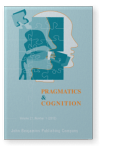Vol. 21:1 (2013) ► pp.193–223
Hedging and rounding in numerical expressions
Previous accounts of hedges assume that they cause language to become vague or fuzzy (Lakoff 1973); however, hedges can actually sharpen numerical concepts by giving explicit information about approximation, especially where bare numbers appear misleadingly round or precise. They can also tell hearers about the direction of approximation (greater or less than). This article provides a first empirical account of interactions between hedging and rounding in numerical expressions. We demonstrate that hedges occur more commonly with round numbers than with non-round ones. However, we also provide evidence from user studies that in the absence of hedges, readers interpret round numbers as approximations and non-round ones as precise; and that placing a hedge before a round number has no effect on its interpretation, whereas placing it before a non-round number shifts people’s interpretations from precise towards approximate. We attempt to explain this conundrum.
Cited by
Cited by 2 other publications
This list is based on CrossRef data as of 13 june 2024. Please note that it may not be complete. Sources presented here have been supplied by the respective publishers. Any errors therein should be reported to them.
